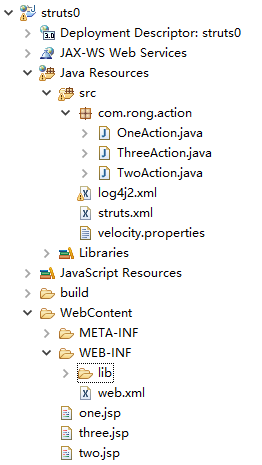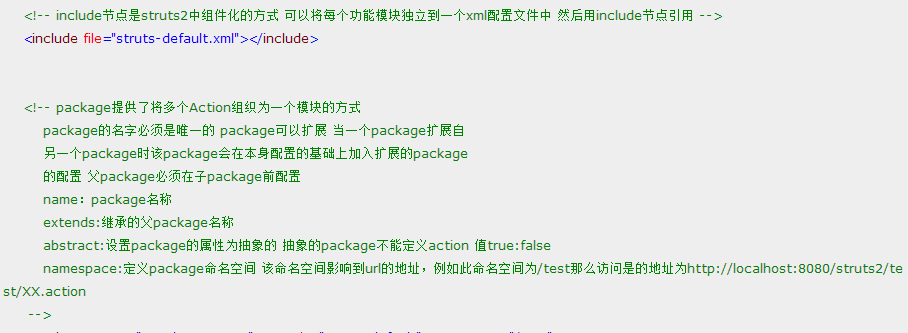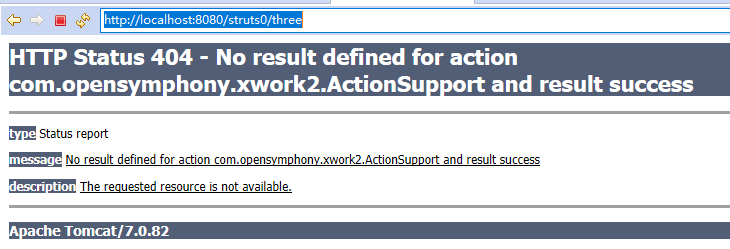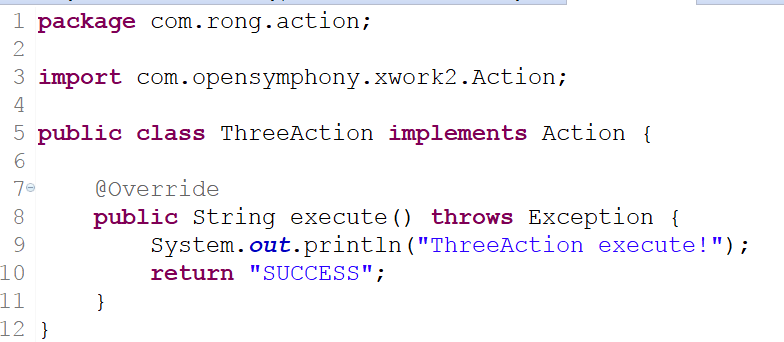1.简介
Struts2是一个基于MVC设计模式的Web应用框架,它本质上相当于一个servlet,在MVC设计模式中,Struts2作为控制器(Controller)来建立模型与视图的数据交互。Struts 2是Struts的下一代产品,是struts 1和WebWork的技术基础上进行了合并的全新的Struts 2框架。其全新的Struts 2的体系结构与Struts 1的体系结构差别巨大。Struts 2以WebWork为核心,采用拦截器的机制来处理用户的请求,这样的设计也使得业务逻辑控制器能够与ServletAPI完全脱离开,所以Struts 2可以理解为WebWork的更新产品。虽然从Struts 1到Struts 2有着太大的变化,但是相对于WebWork,Struts 2的变化很小。
2.执行过程
A.创建过滤器(StrutsPrepareAndExecuteFilter) - 每次请求都执行过滤
1.执行init方法,加载xml文件struts-default.xml,struts-plugin.xml,struts.xml
B.用户访问struts.xml - 执行核心过滤器doFilter()方法
1.创建ActionContext封装数据
把表示request/session/application等的map都放到值栈中.
把值栈数据,拷贝一份给ActionContext
2.struts2把请求封装为一个ActionMapping对象
如果访问的不是action资源,ActionMapping为空,放行!
否则执行Action对象创建以及调用默认拦截器
通过配置管理器对象ConfigurationManager, 创建Action的代理对象此时action对象创建!
创建完Action之后,通过DefaultActionInvocation对象,旧版本依次调用18个拦截器,Struts2的2.5版本是19个
3.然后执行action的execute()方法
4.执行完execute()方法,又回到拦截器,执行invoke()放行之后的代码!
3.简单示例
A.新建web项目
B.导包Struts2-2.5的包(若遇到类似index方法没有定义的问题,可删除Struts-rest的jar包)
可到Apache官网下载jar包

C.在web.xml文件中添加Struts2的filter
1 <?xml version="1.0" encoding="UTF-8"?> 2 <web-app xmlns:xsi="http://www.w3.org/2001/XMLSchema-instance" xmlns="http://java.sun.com/xml/ns/javaee" xsi:schemaLocation="http://java.sun.com/xml/ns/javaee http://java.sun.com/xml/ns/javaee/web-app_3_0.xsd" id="WebApp_ID" version="3.0"> 3 <display-name>struts0</display-name> 4 <welcome-file-list> 5 <welcome-file>index.html</welcome-file> 6 <welcome-file>index.htm</welcome-file> 7 <welcome-file>index.jsp</welcome-file> 8 <welcome-file>default.html</welcome-file> 9 <welcome-file>default.htm</welcome-file> 10 <welcome-file>default.jsp</welcome-file> 11 </welcome-file-list> 12 <!-- 配置Struts2的过滤器 --> 13 <filter> 14 <filter-name>struts</filter-name> 15 <filter-class>org.apache.struts2.dispatcher.filter.StrutsPrepareAndExecuteFilter</filter-class> 16 </filter> 17 <filter-mapping> 18 <filter-name>struts</filter-name> 19 <url-pattern>/*</url-pattern> 20 </filter-mapping> 21 </web-app>
1)通知web服务器(tomcat),只要是/* 的请求路径,都交由该Filter来处理.
2)通过解析和反射struts2的核心Filter,实例化后,加载struts2的相关配置文件,如struts.xml
将struts.xml文件解析后,在内存中形成一个JavaBean对象,每次访问不需要重新加载,直接访问内存。
当重新部署时会重新加载struts.xml形成新的JavaBean对象.
D.写Action类及其方法
1 package com.rong.action; 2 3 public class OneAction { 4 public String index() { 5 System.out.println("toOne Action!"); 6 return "success"; 7 } 8 }
1 package com.rong.action; 2 3 import com.opensymphony.xwork2.ActionSupport; 4 5 public class TwoAction extends ActionSupport { 6 private static final long serialVersionUID = -741546782668382103L; 7 8 public String index() throws Exception { 9 System.out.println("TwoeAction index"); 10 return "two"; 11 } 12 }
1 package com.rong.action; 2 3 import com.opensymphony.xwork2.Action; 4 5 public class ThreeAction implements Action { 6 7 @Override 8 public String execute() throws Exception { 9 System.out.println("ThreeAction execute!"); 10 return "SUCCESS"; 11 } 12 }
E.Struts2的配置文件
<?xml version="1.0" encoding="UTF-8" ?> <!DOCTYPE struts PUBLIC "-//Apache Software Foundation//DTD Struts Configuration 2.5//EN" "http://struts.apache.org/dtds/struts-2.5.dtd"> <struts> <package name="default" namespace="/" extends="struts-default"> <action name="one" method="index" class="com.rong.action.OneAction"> <result name="success">/one.jsp</result> </action> <action name="two" class="com.rong.action.TwoAction" method="index"> <result name="two">/two.jsp</result> </action> <action name="three" class="com.rong.action.ThreeAction"> <result name="SUCCESS">/three.jsp</result> </action> </package> </struts>
访问路径为:
http://localhost:8080/struts0/one
http://localhost:8080/struts0/two
http://localhost:8080/struts0/three
访问Action的规则:
规则:<package>中namespace属性值拼接上<action>中name标签,拼接符为"/"
namespace默认为"/",不对此属性赋值也可以。
两种方式访问Action
方法1,使用.action扩展名 例如:http://localhost:8080/struts0/one.action
方法2,不使用扩展名 例如:http://localhost:8080/struts0/one
两种方式访问效果一样。还可以更改默认扩展名。略。
<package>标签的属性含义:
name="default"------包名
namespace="/" ------访问的空间,该命名空间影响到url的地址
extends="struts-default"------扩展strust2的内部功能,必须是struts-defaul,默认情况下都要经过18拦截器。
<action>标签的属性含义:
name="two"------执行路径
class="com.rong.action.TwoAction"------使用全路径便于反射
method="execute"------需要执行的业务方法,也是通过反射
旧版本不写method就执行默认的execute方法,新版本是index方法!!!
注意:struts2建议将相关的action类放入同一个package下,如CRUD操作,类似于java中的包和类的关系



<action>中不指定class属性会是什么结果?


如果不指定class值,那么会返回404状态值。同时可以看到class属性的默认值为"com.opensymphony.xwork2.ActionSupport"
不写class属性值,要想返回正确的结果,必须在<action>加上result属性,其值必须为"success"。
另外,需要将excute方法的返回值更改为"success"

继承 ActionSupport类后,method默认为excute(),返回值为"success"

<result>中不指定type属性会是什么结果?
重新发布项目,依然是成功,由此可知,type默认为"dispatcher",即默认为转发
如果要使用重定向,必须将type赋值为redirect,即type="redirect"
action使用非单例模式,不需要解决线程安全问题
一次请求对应一次Action实例,因此不会产生线程安全问题,即在Action中不会产生synchronized同步代码块。